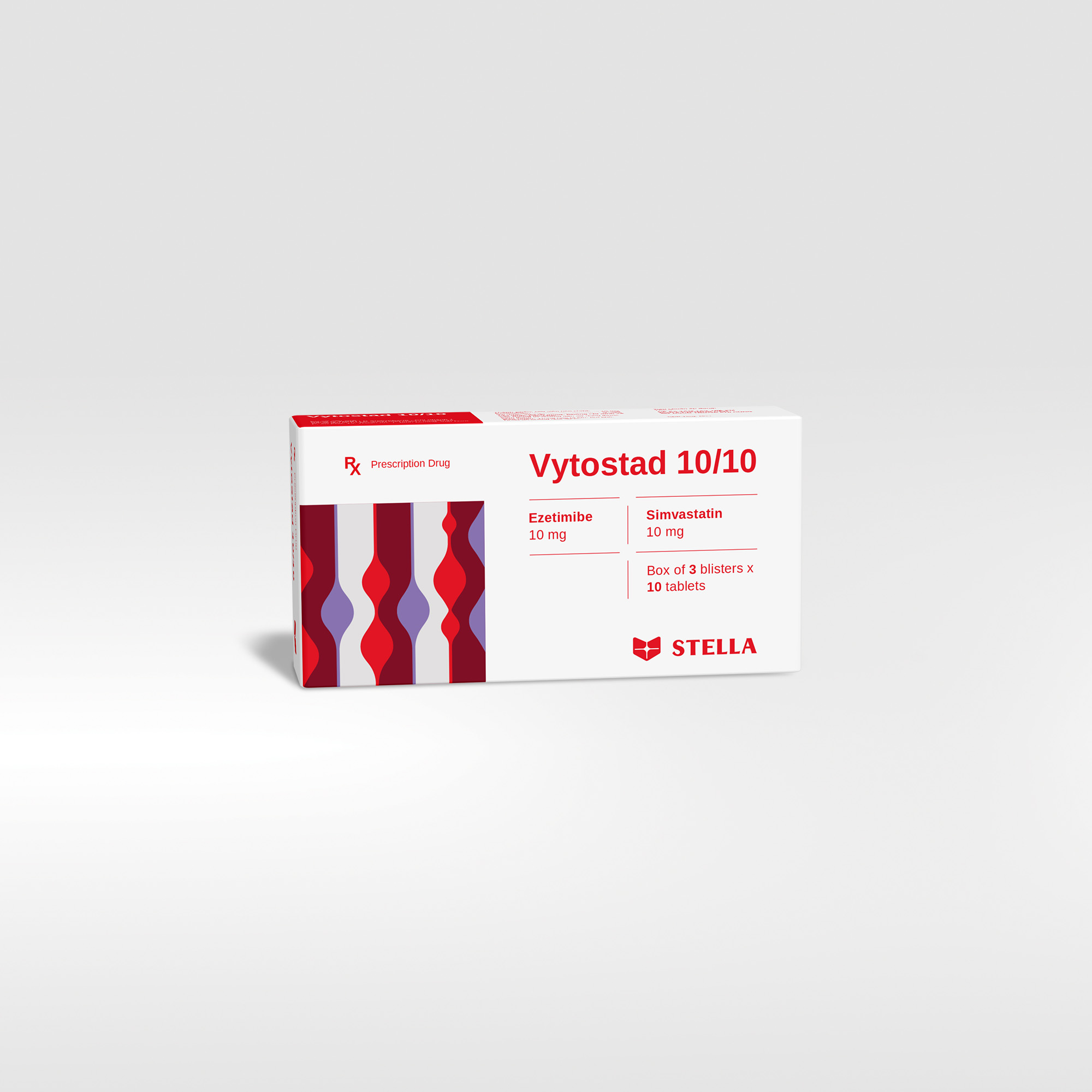Indications
- Primary hyperlipidemia
Vytostad is indicated for the reduction of elevated total cholesterol (total-C), low-density lipoprotein cholesterol (LDL-C), apolipoprotein B (Apo B), triglycerides (TG), and non-high-density lipoprotein cholesterol (non-HDL-C), and to increase high-density lipoprotein cholesterol (HDL-C) in patients with primary (heterozygous familial and non-familial) hyperlipidemia or mixed hyperlipidemia.
- Homozygous familial hypercholesterolemia (HoFH)
Vytostad is indicated for the reduction of elevated total-C and LDL-C in patients with homozygous familial hypercholesterolemia, as an adjunct to other lipid-lowering treatments (e.g., LDL apheresis) or if such treatments are unavailable.
Dosage
Recommended dosing
- The usual dosage range is ezetimibe/simvastatin 10/10 mg/day to 10/40 mg/day.
- The recommended usual starting dose is 10/10 mg/day or 10/20 mg/day.
- After initiation or titration of ezetimibe/simvastatin combination tablet, lipid levels may be analyzed after 2 or more weeks and dosage adjusted, if needed.
Restricted dosing for 10/80 mg
- Due to the increased risk of myopathy, including rhabdomyolysis, particularly during the first year of treatment, use of ezetimibe/simvastatin 10/80 mg should be restricted to patients who have been taking ezetimibe/simvastatin 10/80 mg chronically (e.g., for 12 months or more) without evidence of muscle toxicity.
- Patients who are currently tolerating the 10/80 mg dose of ezetimibe/simvastatin who need to be initiated on an interacting drug that is contraindicated or is associated with a dose cap for simvastatin should be switched to an alternative statin or statin-based regimen with less potential for the drug-drug interaction.
- Due to the increased risk of myopathy, including rhabdomyolysis, associated with the 10/80 mg dose of ezetimibe/simvastatin, patients unable to achieve their LDL-C goal utilizing the 10/40 mg dose of ezetimibe/simvastatin should not be titrated to the 10/80 mg dose, but should be placed on alternative LDL-C-lowering treatment(s) that provides greater LDL-C lowering.
Coadministration with other drugs
- Verapamil, diltiazem, or dronedarone: The dose of ezetimibe/simvastatin should not exceed 10/10 mg/day.
- Amiodarone, amlodipine or ranolazine: The dose of ezetimibe/simvastatin should not exceed 10/20 mg/day.
- Bile acid sequestrants: Dosing of Vytostad should occur either greater than or equal to 2 hours before or greater than or equal to 4 hours after administration of a bile acid sequestrant.
Patients with homozygous familial hypercholesterolemia
- The recommended dosage for patients with homozygous familial hypercholesterolemia is ezetimibe/simvastatin 10/40 mg/day in the evening. Ezetimibe/simvastatin combination tablet should be used as an adjunct to other lipid-lowering treatments (e.g., LDL apheresis) in these patients or if such treatments are unavailable.
- Simvastatin exposure is approximately doubled with concomitant use of lomitapide; therefore, the dose of ezetimibe/simvastatin should be reduced by 50% if initiating lomitapide.
- Ezetimibe/simvastatin dosage should not exceed 10/20 mg/day (or 10/40 mg/day for patients who have previously taken simvastatin 80 mg/day chronically, e.g., for 12 months or more, without evidence of muscle toxicity) while taking lomitapide.
Patients with renal impairment/chronic kidney disease
- In patients with mild renal impairment (estimated GFR greater than or equal to 60 ml/min/1.73 m2), no dosage adjustment is necessary. In patients with chronic kidney disease and estimated glomerular filtration rate less than 60 ml/min/1.73 m2, the dose of Vytostad is 10/20 mg/day in the evening. In such patients, higher doses should be used with caution and close monitoring.
Geriatric patients
- No dosage adjustment is necessary.
- Use of suitable preparations is recommended when using ezetimibe/simvastatin with dose of 10/40 mg and 10/80 mg.
Usage
- Vytostad is administered orally. It should be taken as a single daily dose in the evening, with or without food.













